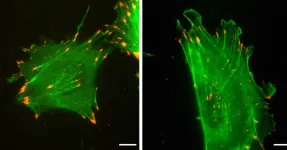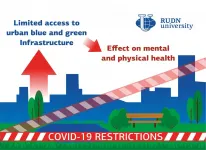(Press-News.org) The protein actin is ubiquitous and essential for life. In mammals, every cell expresses two of its forms, beta-actin and gamma-nonmuscle-actin. Despite having distinct roles, the two forms are nearly identical, sharing 99% of their amino acid sequence.
Research by Anna Kashina of Penn's School of Veterinary Medicine and colleagues has shown that, contrary to scientific dogma, it's not the slight differences in amino acid sequence that govern these proteins' discrete functions in the cell. Rather, their nucleotide sequences--the "letters" that make up their DNA coding sequence, which differ by roughly 13% between the two forms--are responsible for their individual roles in organisms' survival and cell migration.
And in a new study the researchers offer an explanation for why: Beta-actin mRNA is translated into protein faster than gamma-actin. Both forms help cells move, but beta-actin's faster rate seems to cause cell to affix to a substrate more strongly, slowing down cell movement.
"On a global, philosophical level, this expands our understanding of genetic code," says Kashina, a professor of biochemistry at Penn Vet and the senior author on the study, which was published in the journal eLife. "We used to believe that the role of the nucleotides was to encode amino acids, but now we see that, actually, proteins with the same amino acid sequence have different translation rates, and that makes a difference in their function."
Kashina uses the term "silent code" to refer to the influence of these nucleotide differences. In earlier work, her team showed that, in mice, editing the amino acid sequence but maintaining the silent nucleotide code could cause gamma-actin to behave like beta-actin in the body. Normally, mice lacking beta-actin would die before birth, but the researchers showed that performing gene editing to the beta-actin gene so it had the same amino acid sequence as gamma-actin kept mice alive thanks to the nucleotide differences.
A finding from an earlier paper, also published in eLife, motivated the new work. In that earlier study the researchers found that beta-actin RNA had a much higher density of ribosomes than that of gamma-actin. Ribosomes are crucial to the synthesis of protein from RNA, leading the scientists to hypothesize that this difference in protein translation rate could be responsible for the different functions between gamma and beta-actin.
To test their idea, they used cell lines to express only the coding sections of beta- and gamma-actin in mouse cells, as well as their edited versions: the beta-actin that had been edited to have the same amino acid sequence as gamma-actin and vice versa for gamma-actin.
When put to the test in a wound-healing experiment, the researchers found that the nucleotide sequence was paramount in determining the speed at which actin facilitated cell movement. Cells expressing only the typical beta-actin migrated at typical rates, but gamma-actin-expressing cells moved twice as fast. The cells containing edited versions of actin proved that this difference is nucleotide-sequence dependent. Beta-actin edited to have the amino acid sequence of gamma moved like gamma-actin-expressing cells, and those with gamma-actin edited to have the amino acid sequence of beta-actin moved at the rate of beta-actin-expressing cells.
These results surprised the researchers since they expected the higher density of ribosomes in beta-actin mRNA could support faster translation and thus faster movement. And, indeed, when they measured the rate of translation on a single-molecule level, they found that translation occurs about twice as fast for beta-actin as for gamma-actin.
"We expected that faster translation would mean faster movement," Kashina says, "and that's not what we found. It took us a long time to explain why."
What they eventually discovered, was that although the subunits of beta-actin could be supplied faster than those of gamma-actin, that speed worked to the detriment of cell migration speed.
"We found that the faster you supply it, the better the cell attaches to the substrate," Kashina says. "It creates proper traction, which is essential for normal migration. And if you don't supply it fast enough the cell can't attach properly and starts sliding. So that explained our seemingly counterintuitive results."
Kashina and colleagues plan to continue to probe the role of the nucleotide sequence, including why evolutionary forces led to the production of such similar forms of actin and whether the "silent code" is at work in other proteins.
"We think this is part of a bigger story," Kashina says. "We believe actins are not the only proteins that behave this way. There are a number of protein families in the human genome that contain highly similar proteins encoded by different genes. This silent code could be at play in those families as well."
INFORMATION:
Anna Kashina is a professor of biochemistry in the University of Pennsylvania School of Veterinary Medicine.
Kashina's coauthors on the study were Penn Vet's Pavan Vedula, Brittany MacTaggart, and Dawei Dong; Satoshi Kurosaka of Japan's Kindai University's; the University of Maryland's Qin Ni and Garegin A. Papoian; and Georgia State University's Yi Jiang.
The study was supported by the National Institutes of Health (grants GM122505, CA201340, and EY028450) and National Science Foundation (grants 1800418 and 1806903).
Researchers have produced vaccine-like immune responses to a dangerous bacterium by colonizing 26 healthy volunteers with a related, but harmless, commensal bacterial species. The first-in-human, controlled infection study showed the strategy was safe, as no side effects were reported and the volunteers didn't transmit the commensal bacteria to bedroom-sharers over the 90-day study. Neisseria lactamica is a member of the microbiome that usually resides in the upper airways of children but can also safely colonize the airways of adults. Some researchers theorize that these bacteria ...
By 2050, faster adoption of electric vehicles (EVs) and faster generation of renewable energy will result in 99% less fossil fuel consumed and 93% less CO2 emissions from passenger and freight vehicles on O?ahu. That's under the most ambitious scenario in an article published in World Electric Vehicle Journal, by University of Hawai?i at Mānoa School of Ocean and Earth Science and Technology (SOEST) faculty member Katherine McKenzie.
McKenzie, based at the Hawai?i Natural Energy Institute in SOEST, created mathematical models of four scenarios based on projections for the switch to electric passenger and freight ...
Five years ago, researchers at Northwestern University made international headlines when they discovered that human eggs, when fertilized by sperm, release billions of zinc ions, dubbed "zinc sparks."
Now, Northwestern has teamed up with the U.S. Department of Energy's (DOE) Argonne National Laboratory and Michigan State University (MSU) to reveal that these same sparks fly from highly specialized metal-loaded compartments at the egg surface when frog eggs are fertilized. This means that the early chemistry of conception has evolutionary roots going back at least 300 million years, to the last common ancestor between frogs and people.
"This work may help inform our understanding of the interplay of dietary zinc status and human fertility." -- Thomas O'Halloran, professor, Michigan State ...
The measures taken during the COVID-19 pandemic limited the access of citizens to natural objects. It is still unexplored, what consequences this had for the residents and what conclusions should be drawn for more effective urban planning. RUDN University scientists with colleagues from Australia and Germany studied how the restrictions associated with COVID-19 affected the use of blue and green infrastructure by citizens in Moscow (Russia) and Perth (Australia), and what consequences this had for their health. In the article "Human Dimensions of Urban Blue and Green Infrastructure during a Pandemic. The Case Study of Moscow (Russia) ...
Bahamian mosquitofish in habitats fragmented by human activity are more willing to explore their environment, more stressed by change and have smaller brain regions associated with fear response than mosquitofish from unaffected habitats. The new study from North Carolina State University shows that these fish have adapted quickly in specific ways to human-driven change, and cautions that environmental restoration projects should understand these changes so as not to damage adapted populations.
The Bahamas mosquitofish is a small, coastal fish species that frequently inhabits tidal creeks - shallow, tidally influenced marine ecosystems. ...
In 2019, Anaïs Llorens and Athina Tzovara -- one a current, the other a former University of California, Berkeley, postdoctoral scholar at the Helen Wills Neuroscience Institute (HWNI) -- were attending a scientific meeting and pleased that one session, on gender bias in academia, attracted nearly a full house. The problem: The audience of some 300 was almost all women.
Where were the men, they wondered? More than 75% of all tenured faculty in Ph.D. programs around the world are men, making their participation key to solving the problem of gender bias, which negatively impacts the careers, work-life balance and mental health of all women in science, and even more ...
FOR IMMEDIATE RELEASE
In what turned out to be one of the most important accidents of all time, Scottish bacteriologist Alexander Fleming returned to his laboratory after a vacation in 1928 to find a clear zone surrounding a piece of mold that had infiltrated a petri dish full of Staphylococcus aureus (S. aureus), a common skin bacterium he was growing.
That region of no bacterial growth was the unplanned birth of a medical miracle, penicillin, and would lead to the era of antibiotics. Now, END ...
When gravitational waves were first detected in 2015 by the advanced Laser Interferometer Gravitational-Wave Observatory (LIGO), they sent a ripple through the scientific community, as they confirmed another of Einstein's theories and marked the birth of gravitational wave astronomy. Five years later, numerous gravitational wave sources have been detected, including the first observation of two colliding neutron stars in gravitational and electromagnetic waves.
As LIGO and its international partners continue to upgrade their detectors' sensitivity to gravitational waves, they will be able to probe a larger volume of the universe, thereby making the detection ...
As the COVID-19 pandemic wanes in the U.S., a new study from the University of Maryland School of Medicine (UMSOM) and University of Maryland Medical Center (UMMC) finds that hospitals nationwide may not be adequately prepared for the next pandemic. A 10-year analysis of hospitals' preparedness for pandemics and other mass casualty events found only marginal improvements in a measurement to assess preparedness during the years leading up to the COVID-19 pandemic. The study was published last month in the Journal of Healthcare Management.
"Our work links objective healthcare data to a hospital score that ...
If a virtual world has ever left you feeling nauseous or disorientated, you're familiar with cybersickness, and you're hardly alone. The intensity of virtual reality (VR)--whether that's standing on the edge of a waterfall in Yosemite or engaging in tank combat with your friends--creates a stomach-churning challenge for 30-80% of users.
In a first-of-its kind study, researchers at the University of Maryland recorded VR users' brain activity using electroencephalography (EEG) to better understand and work toward solutions to prevent cybersickness. The research was conducted by Eric Krokos, who received his Ph.D. in computer science in 2018, and Amitabh Varshney, a professor of computer science ...






